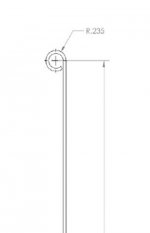Have a project that requires a closed loop of 1/16” 304 stainless wire that has a finished OD of 0.47 on the end of a straight length of the wire that is 10” long. The end of the wire loop needs to be within .020 of touching the straight section. I have attempted a mandrel that is .305” and tightly wrapped about 1-3/4” turns around it which after spring back is pretty close to the desired measurement but requires cutting the tag end and trying to hand bend the loop back into into the same plane while keeping the end within the .020” gap. I know wire bending machines are probably the solution but the quantity of these needed don’t warrant the investment in a wire machine.
Any suggestions on how to do this efficiently?
Thx
Dan
Any suggestions on how to do this efficiently?
Thx
Dan



